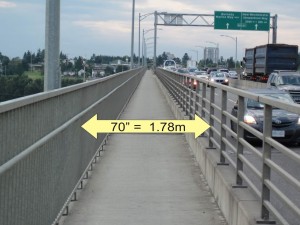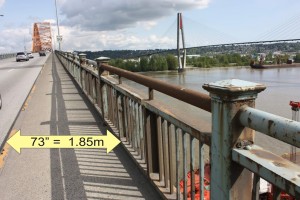I ride my bike across the Queensborough Bridge several times a week; during the summer my weekly crossing pattern exceeds “several”, verging upon “numerous” territory. All things considered, it is a pretty good crossing. Not as plush as the bike lane affixed to the new Canada Line Bridge, and I have already whinged on about the wayfinding signage, but it is a safe, serviceable combined pedestrian-bike route, at least in comparison with some other crossings, like the Pattullo.
In fact, improving bike and pedestrian facilities is always mentioned as a big benefit of replacing the Pattullo. TransLink suggests that a modern bike path hung on both sides of a new 6-lane bridge would increase cyclist and pedestrian use of the bridge by some 3500%, which is a ridiculously ambitious number considering the current paucity of destinations attractive to cyclists and pedestrians on the Surrey side of the bridge. However, let’s skip over that and talk about how a 6-lane Pattullo will help cycling in general, and what the best way to help cyclist might be on this crossing.
It is pretty clear from TransLink’s Phase 3 “consultation” that the “Upstream Option A” is the preferred option for TransLink’s technical reasoning, and the least offensive of a bad lot for the public. The problem being that the spaghetti-patterns of lanes look like they will severely complicate the bike routes and pedestrian routes through the corridors at both ends, where right now, the connections are simple, safe, and effective.
The current configuration for the Pattullo connects very well to the Central Valley Greenway in New West, and also provides a relatively safe connection to the upper parts of New West across Royal Ave via First Street. The path that loops under the bridge could be improved (a longer, looping ramp where there are now stairs would improve things immeasurably), but we are talking a few metres of pavement here, not a major infrastructure work. The connections on the Surrey side are also super-friendly, dropping cyclists onto a traffic-calm 111A Avenue, with dedicated bike lanes connecting to the SkyTrain station and points east, and to Brownsville Bar Park. It seems to me that the changes proposed at each end could actually make cycling access worse!
As a bit of an aside, TransLink explained to me again and again that there would be bike paths on both sides of the new bridge. I kept asking why, and they countered with the idea that more bike lanes the better. I, for one, would rather have one good, serviceable bike lane than two sub-optimal ones (no need for a second one on the Canada Line Bridge!). Two lanes doubles the complicated connection routes, and raises costs where one lane would suffice.
To look at this problem from another angle, compare the Pattullo to the Queensborough, and it becomes clear the only problem with Pattullo’s current bike/pedestrian infrastructure is the absence of a barrier between the sidewalk and the cars. Here is the current (acceptable to most, including the BC Ministry of Transportation) bike path on the Queensborough Bridge, with a measurement of the space between the rails I took on a recent ride:
And here is a photo I took of the Pattullo sidewalk, with a measure of the sidewalk width:
Presumably, a 4 or 5 foot high metal barrier, similar to the one on the Queensborough, could be installed on the Pattullo, similar to the one suggested in the 2011 Options Analysis for the Pattullo. If the entire structure were 5” thick, the resultant pathway would only be an inch or two narrower than the Queensborough bike path, for a fraction of the cost of a new bridge; even a fraction of the cost of the “Bicycle Infrastructure” part of a new bridge.
Maybe this is the secret reason they are closing the Pattullo this weekend? They are installing barriers to make cyclists safe?
I’m not suggesting that this would result in the best bike path in the Lower Mainland, I’m just saying that the bike infrastructure on the Pattullo Bridge can be easily and cost-effectively improved in a substantial way, to safely accommodate the practical number of cyclists who will use the bridge, without impacting traffic flows for all them trucks, and without the need for an all-new bridge.
When you add in the $Billion cost of the new bridge, and the significant problems it will cause by bringing more traffic into New Westminster (with resultant worsening of the bike and pedestrian experience), and the potential worsening of the connections at each end to the existing cycling network, I am compelled to argue that the “repair and restore” option (Rather like another recent example with good cycling and pedestrian infrastructure) might be the the result with the best new benefit for pedestrians and cyclists.
Oh, and while we are at it, if we can get just a bit of the $700 million saved on bridge replacement for other bike improvements in the region, say just 10% of the savings, then we are talking serious imporvements to the system elsewhere. Let’s hope we don’t go through the same experience as they did with the Canada Line Bridge. For those with short memories: that $10Million bike and pedestrian bridge I was glowing about back at the beginning of this post? It was not part of the Canada Line’s $2Billion budget. The Province and Feds wouldn’t agree to pay for such a vital piece of infrastructure to include ped and bike access (hey, no-one was going to ride their bikes to the Olympics!), so TransLink was left to dig up $10 Million from their bicycle capital program and other sources, to connect cycling and pedestrian access to a major piece of infrastructure. A sad testament to our regional planning, when for want of ½ of 1% of the Canada Line budget, TransLink had to scramble to find more money equal to 3000% of their annual budgeted system-wide Bicycle Capital Programs.
That was not, however, TransLink’s fault (remember, they are the ones who did cough up the extra dough when it was needed), it was the Senior Government “Partners” and PPP profiteers who built the Canada Line. Much like the FalconGates, TransLink was forced to shoe-horn bad policy making from above into an already cash-strapped situation on the ground. This is why I don’t see the Pattullo issue as “New Westminster vs. TransLink”, but as the TransLink-funding public giving TransLink the political backing required for them to follow their own Transport 2040 Plan, in face of relenting pressure from… well, the “from” part is another post altogether.


Now, now, remember the Canada Line was not at allllll related to the Olympics and Olympic costs Falcon and Gordy kept telling us. It was purely a coincidence it was built in exactly the right time for the Olympics. Otherwise that $2 billion would have to be included in the overall Olympics costs.